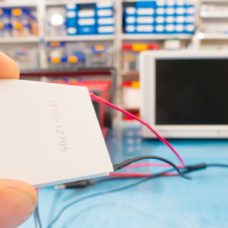A tiny silicon-based device able to generate electricity from waste heat pushes forward waste-to-energy technology and could, in the future, be used for space missions and hybrid cars.
Every engine and power generating system creates waste heat. Over the years, many research teams and companies have tried to create a device which can recapture this heat and transform it back into electrical energy.
Now, an American based laboratory could have cracked the problem.
Tiny Waste-to-Energy Device With Big Potential
Sandia National Laboratories is a federally-funded institution that runs two principal labs in California and in New Mexico.
Turning waste heat into a sustainable renewable energy source is one of the many focus research areas at Sandia.
The latest WtE solution that came out of Sandia labs is a device that captures and converts waste heat into electricity.
Sandia researchers who developed the device call it rectenna, (rectifying + antenna).
The infrared rectenna components are made of silicon, silicon dioxide, aluminum and glass, all crammed in a tiny 1/8 per 1/8 inch space.
Being based on such common and abundant materials, rectenna devices can be produced at a large-scale via conventional fabrication processes of the circuit industry.
“We’ve deliberately focused on common materials and processes that are scalable. In theory, any commercial integrated circuit fabrication facility could make these rectennas,” said Joshua Shank, a research team member.
With no moving parts, rectennas are compact enough to resist stress that may cause them to break, bend, or jam.
To protect the device from heat stress, the system doesn’t even have to come into direct touch with the thermal source to do the job.
Hybrid Cars and Space Missions Could use Rectennas
At 8 nW/cm2 of electricity (nanowatts per square centimeter), the prototype rectenna, described in Physical Review Applied, can’t even power an average solar-powered calculator, which needs about 5 microwatts, or 5,000 nanowatts.
Yet, the team have faith in their invention that they think can refine the design and improve rectennas’ performance.
“Car engines produce a lot of heat and that heat is just waste, right? So imagine if you could convert that engine heat into electrical power for a hybrid car. This is the first step in that direction, but much more work needs to be done,” said Paul Davids, a physicist at Sandia and the study’s principal investigator.
Not only hybrid electric cars can integrate rectenna devices into their systems for more efficiency, SpaceX and other commercial space companies will also be interested in this technology.
“In the short term we’re looking to make a compact infrared power supply, perhaps to replace radioisotope thermoelectric generators,” said Davids.
For space missions, Radioisotope Thermoelectric Generators (RTGs) are used to power some devices and instruments, like sensors, that are not usually exposed to direct sunlight to power solar panels.


















Comments (0)
Most Recent